Welcome to our free classical music site

Do you write about classical music? Are you a blogger? Want to team up with Classical Connect? Send us a message, let's talk!

Do you write about classical music? Are you a blogger? Want to team up with Classical Connect? Send us a message, let's talk!
June 3, 2013. Robert Schumann and more. One of the greatest Romantic composers, Robert Schumann was born on June 8, 1810 in Zwickau, Saxony. Schumann is central to modern music, especially the piano repertory, and we wrote about him and featured his music many times (our library contains more than 200 recordings of his music).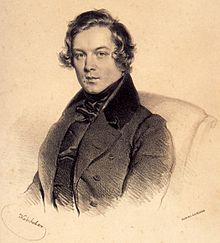 Schumann was also highly creative as a critic, and practically invented the genre of “programmatic” music. All of his early compositions were for the piano, but he started writing for other instruments later in his career. Schumann turned out to be an extraordinary songwriter, second probably only to Schubert. He composed the cycle Dichterliebe (The Poet's Love) in 1840. It consists of 16 songs, the texts to which come from Heinrich Heine’s Lyrisches Intermezzo. The cycle was dedicated to the great German soprano Wilhelmine Schröder-Devrient, so we know that Schumann intended it for a female voice. The music was too good to be passed up by the male singers though, and is performed by them at least as often. The great German baritone Dietrich Fischer-Dieskau recorded Dichterliebe several times, among his collaborators were Vladimir Horowitz and Alfred Brendel. So did the French baritone Gérard Souzay (we recently heard him exquisitely singing an aria from Lully’s Cadmus et Hermione). The tenors Peter Schreier and, closer to our times, Ian Bostridge made memorable recordings as well. The famed Lotte Lehmann recorded the cycle with the conductor Bruno Walter at the piano in 1940; several years later Walter accompany Kathleen Ferrier in yet another recording. One of the very best, at least in our opinion, is the recording made by the great German tenor Fritz Wunderlich. Accompanied by Hubert Giesen, Wunderlich made this recording in October and November of 1965 and July 1966, just two months before his untimely death at the age of 36. It was too difficult to select "favorite" sections, so here it is, in its entirely.
Schumann was also highly creative as a critic, and practically invented the genre of “programmatic” music. All of his early compositions were for the piano, but he started writing for other instruments later in his career. Schumann turned out to be an extraordinary songwriter, second probably only to Schubert. He composed the cycle Dichterliebe (The Poet's Love) in 1840. It consists of 16 songs, the texts to which come from Heinrich Heine’s Lyrisches Intermezzo. The cycle was dedicated to the great German soprano Wilhelmine Schröder-Devrient, so we know that Schumann intended it for a female voice. The music was too good to be passed up by the male singers though, and is performed by them at least as often. The great German baritone Dietrich Fischer-Dieskau recorded Dichterliebe several times, among his collaborators were Vladimir Horowitz and Alfred Brendel. So did the French baritone Gérard Souzay (we recently heard him exquisitely singing an aria from Lully’s Cadmus et Hermione). The tenors Peter Schreier and, closer to our times, Ian Bostridge made memorable recordings as well. The famed Lotte Lehmann recorded the cycle with the conductor Bruno Walter at the piano in 1940; several years later Walter accompany Kathleen Ferrier in yet another recording. One of the very best, at least in our opinion, is the recording made by the great German tenor Fritz Wunderlich. Accompanied by Hubert Giesen, Wunderlich made this recording in October and November of 1965 and July 1966, just two months before his untimely death at the age of 36. It was too difficult to select "favorite" sections, so here it is, in its entirely.
Several other composers were born around this date, and we’ll write more about them at a later date, but here are two of them: the peripatetic Scott, Georg Muffat was born on June 1, 1653 in Savoy. Here is his Sonata No. 2 in G minor from the set known as Armonico Tributo. Composed in Rome, Armonico was clearly influenced by Arcangelo Corelli, whom Muffat met while staying in the city. The Sonata is performed by Ensemble 415, Chiara Banchini conducting. A century and a half later, also on June 1 but of 1804, Mikhail Glinka, "the father of Russian classical music," was born. Like Muffat, he was influenced by the Italians, but had enough of his own original talent to produce operas that are staged even today, and not just in Russia. Here is his Overture to the 1842 opera Ruslan and Lyudmila. The recording was made by Evgeny Mravinsky and his famed Leningrad Philharmonic in concert in 1965. It’s probably the speediest rendition of the Overture in the recording history, but the strings manage to play (practically) every note.Permalink
May 27, 2013. Albéniz and Korngold. Isaac Albéniz, the oldest of the three composers who put Spanish music back on the music map (the other two being Granados and de Falla), was born on May 29, 1860 in a small town of Camprodon in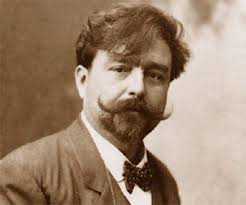 northern Catalonia. He was a piano prodigy and started performing at the age of four. Legend has it that he ran away from home twice before reaching the age of 13, each time supporting himself by playing public concert. At the age of seven he passed the piano entrance exams at the Paris Conservatory but wasn’t admitted because of his age. At 14 he briefly went to the Leipzig conservatory and when money run out, to Brussels’s Royal Conservatory where he received a grant. In 1883 he returned to Spain to teach in Madrid and Barcelona. Albéniz was composing from an early age but took the craft seriously only after meeting Felipe Pedrell, a teacher and composer, around the time he returned to Spain. Three years later, in 1886, he composed Suite española for piano. The suite consists of eight pieces, each dedicated to different regions of Spain (the last one is called Cuba, then a Spanish colony). In 1893 Albéniz moved to Paris, where he befriended Vincent d’Indy, Paul Dukas, and other composers. Between 1905 and 1909 he wrote Iberia, a set of four “books,” each containing three pieces. Iberia became his most famous and popular composition. (The wonderful Spanish pianist Alicia de Larrocha was one of the best interpreters of Albéniz’s music. Here she is playing Book 1 of Iberia: Evocación, El puerto and Fête-dieu à Seville). By that time Albéniz was very sick with a kidney disease. He died on May 18, 1909, age 48, in Cambo-les-Bains, a French Basque town on the border of Spain.
northern Catalonia. He was a piano prodigy and started performing at the age of four. Legend has it that he ran away from home twice before reaching the age of 13, each time supporting himself by playing public concert. At the age of seven he passed the piano entrance exams at the Paris Conservatory but wasn’t admitted because of his age. At 14 he briefly went to the Leipzig conservatory and when money run out, to Brussels’s Royal Conservatory where he received a grant. In 1883 he returned to Spain to teach in Madrid and Barcelona. Albéniz was composing from an early age but took the craft seriously only after meeting Felipe Pedrell, a teacher and composer, around the time he returned to Spain. Three years later, in 1886, he composed Suite española for piano. The suite consists of eight pieces, each dedicated to different regions of Spain (the last one is called Cuba, then a Spanish colony). In 1893 Albéniz moved to Paris, where he befriended Vincent d’Indy, Paul Dukas, and other composers. Between 1905 and 1909 he wrote Iberia, a set of four “books,” each containing three pieces. Iberia became his most famous and popular composition. (The wonderful Spanish pianist Alicia de Larrocha was one of the best interpreters of Albéniz’s music. Here she is playing Book 1 of Iberia: Evocación, El puerto and Fête-dieu à Seville). By that time Albéniz was very sick with a kidney disease. He died on May 18, 1909, age 48, in Cambo-les-Bains, a French Basque town on the border of Spain.
Erich Wolfgang Korngold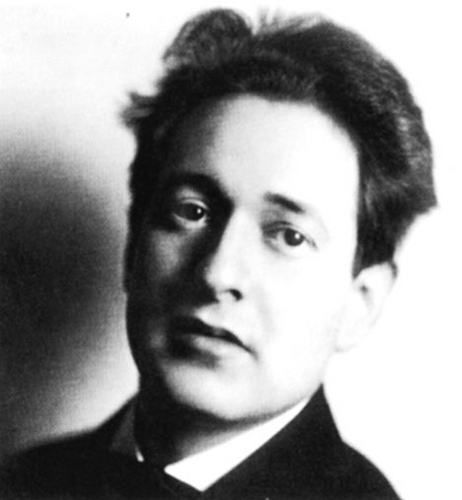 was born on May 29, 1897 in Brno, the capital of Moravia in the Czech Republic, back then called Brünn and part of Austria-Hungary. Korngold’s story is highly unusual. He was an amazing child prodigy, and in his youth was compared to Mozart. At the age of nine he showed his cantata, Gold, to Gustav Mahler, who pronounced him a musical genius and suggested that Korngold study with Alexander von Zemlinsky. At the age of 11 he composed a ballet, which was staged at the Vienna Opera in 1910 and performed for the Emperor Franz Josef. He wrote his first orchestral piece when he was 14 and then at 17 not just one but two operas. When he was 23 he composed Die tote Stadt (The Dead City), a major opera. At that time Korngold was so famous that opera theaters competed to premier his work. In the end, it was performed simultaneously in two cities, Hamburg and Cologne (in Cologne the conductor was none other than Otto Klemperer). Later on the Nazis banned the opera (Korngold was Jewish), and it disappeared from the repertoire of the major houses. Die tote Stadt wаs revived about 30 years ago and these days is staged often. In 1923 he wrote a Concerto for Piano Left Hand for pianist Paul Wittgenstein, who lost his right hand in World War I (Ravel also wrote his famous Concerto for the Left Hand for Wittgenstein, as did Prokofiev with his concerto no. 4, although Wittgenstein never performed it). In 1934 Korngold was invited to write music for theater and film in Hollywood, which he did very successfully. He returned to Austria, but in 1938 Warner Brothers invited him back to compose the music to a new Errol Flynn movie called The Adventures of Robin Hood. While he was in California, Hitler and his army entered Austria in what became known as Anschluss (later on Korngold would say that Robin Hood saved his life). He continued writing film scores, very successfully until 1946, but that whole period was lost to the classical music. He returned to classical composition with the Violin Concerto (premiered in 1947), but his style, rich, melodic and highly romantic, was completely out of vogue: it was way behind the Second Viennese School of Schoenberg and his disciples, behind Stravinsky, Bartok and so many others. Music critics considered him a “film composer,” a disdainful designation. It’s hard to imagine a greater transformation than what Korngold’s reputation underwent, from “genius” to a complete “has-been.” The last 40 years saw somewhat of a rehabilitation: several of his operas were staged and recorded, the violin concerto became popular again, and so did some of his symphonic works. It’s clear that Korngold never fulfilled the great promise of his early years; nonetheless, he was a composer of talent, even if this talent didn’t quite fit the musical developments of the 20th century. Here is Marietta’s Lied from Die tote Stadt, sung by the incomparable Renée Fleming. And here Hilary Hahn performs Korngold’s Violin Concerto in D major, Op. 35. Deutsche Symphonie Orchestra is conducted by Kent Nagano.
was born on May 29, 1897 in Brno, the capital of Moravia in the Czech Republic, back then called Brünn and part of Austria-Hungary. Korngold’s story is highly unusual. He was an amazing child prodigy, and in his youth was compared to Mozart. At the age of nine he showed his cantata, Gold, to Gustav Mahler, who pronounced him a musical genius and suggested that Korngold study with Alexander von Zemlinsky. At the age of 11 he composed a ballet, which was staged at the Vienna Opera in 1910 and performed for the Emperor Franz Josef. He wrote his first orchestral piece when he was 14 and then at 17 not just one but two operas. When he was 23 he composed Die tote Stadt (The Dead City), a major opera. At that time Korngold was so famous that opera theaters competed to premier his work. In the end, it was performed simultaneously in two cities, Hamburg and Cologne (in Cologne the conductor was none other than Otto Klemperer). Later on the Nazis banned the opera (Korngold was Jewish), and it disappeared from the repertoire of the major houses. Die tote Stadt wаs revived about 30 years ago and these days is staged often. In 1923 he wrote a Concerto for Piano Left Hand for pianist Paul Wittgenstein, who lost his right hand in World War I (Ravel also wrote his famous Concerto for the Left Hand for Wittgenstein, as did Prokofiev with his concerto no. 4, although Wittgenstein never performed it). In 1934 Korngold was invited to write music for theater and film in Hollywood, which he did very successfully. He returned to Austria, but in 1938 Warner Brothers invited him back to compose the music to a new Errol Flynn movie called The Adventures of Robin Hood. While he was in California, Hitler and his army entered Austria in what became known as Anschluss (later on Korngold would say that Robin Hood saved his life). He continued writing film scores, very successfully until 1946, but that whole period was lost to the classical music. He returned to classical composition with the Violin Concerto (premiered in 1947), but his style, rich, melodic and highly romantic, was completely out of vogue: it was way behind the Second Viennese School of Schoenberg and his disciples, behind Stravinsky, Bartok and so many others. Music critics considered him a “film composer,” a disdainful designation. It’s hard to imagine a greater transformation than what Korngold’s reputation underwent, from “genius” to a complete “has-been.” The last 40 years saw somewhat of a rehabilitation: several of his operas were staged and recorded, the violin concerto became popular again, and so did some of his symphonic works. It’s clear that Korngold never fulfilled the great promise of his early years; nonetheless, he was a composer of talent, even if this talent didn’t quite fit the musical developments of the 20th century. Here is Marietta’s Lied from Die tote Stadt, sung by the incomparable Renée Fleming. And here Hilary Hahn performs Korngold’s Violin Concerto in D major, Op. 35. Deutsche Symphonie Orchestra is conducted by Kent Nagano.
PermalinkMay 20, 2013. Richard Wagner 200. Richard Wagner, this most exasperating of musical geniuses, was born on May 22, 1813 in Leipzig. He was one of the most influential composers of the 19th century; the list of musicians indebted to Wagner is enormous, from Anton Bruckner, Gustav Mahler, Hugo Wolf and early Arnold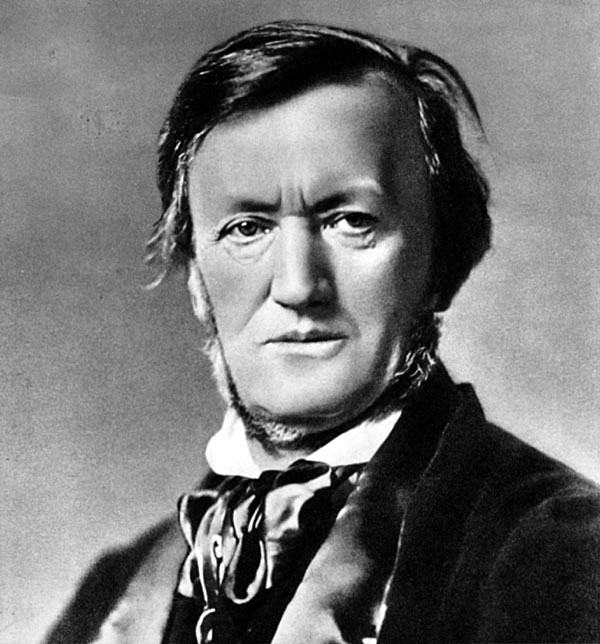 Schoenberg in Germany to César Franck, Ernest Chausson, Jules Massenet and Claude Debussy in the francophone world (Debussy struggled with Wagner’s influence for years). And it went well beyond opera: philosophers, starting with Friedrich Nietzsche, poets, such as Baudelaire, Mallarmé and Verlaine, also writers, too many to mention, even painters fell under his spell. Wagner had his detractors too: the German music world at the time was divided into “Wagnerites” on one side and followers of Brahms on the other. Eduard Hanslick, an influential music critic, was an enemy. Wagner was probably the only composer for whom an opera house was built: King Ludwig II of Bavaria, his major patron, helped to finance its construction in Bayreuth. It was completed in 1876, just in time for the permier of Der Ring des Nibelungen cycle. Wagner was also a notorious anti-semite and racist, but of course we cannot hold him responcible for the Nazi’s appropriation of his music half a century later.
Schoenberg in Germany to César Franck, Ernest Chausson, Jules Massenet and Claude Debussy in the francophone world (Debussy struggled with Wagner’s influence for years). And it went well beyond opera: philosophers, starting with Friedrich Nietzsche, poets, such as Baudelaire, Mallarmé and Verlaine, also writers, too many to mention, even painters fell under his spell. Wagner had his detractors too: the German music world at the time was divided into “Wagnerites” on one side and followers of Brahms on the other. Eduard Hanslick, an influential music critic, was an enemy. Wagner was probably the only composer for whom an opera house was built: King Ludwig II of Bavaria, his major patron, helped to finance its construction in Bayreuth. It was completed in 1876, just in time for the permier of Der Ring des Nibelungen cycle. Wagner was also a notorious anti-semite and racist, but of course we cannot hold him responcible for the Nazi’s appropriation of his music half a century later.
Wagner wrote some symphonic music, none of it very successul. His genius was fully realized in his operas, from the early Rienzi (1842) and The Flying Dutchman (1843), to Tannhäuser (1845) and Lohengrin (1850). He started writing the story of Siegfried's Death in 1848. He eventually expanded and rewrote the original libretto and turned it into the cycle of four operas called Der Ring des Nibelungen. He started composing the first opera of the cycle, Das Rheingold, in 1853 and completed the Cycle in 1874 with Götterdämmerung. In 1857 he temporarily stopped working on the Cycle and wrote one of his greatest creations, the mesmerizing Tristan und Isolde. Die Meistersinger von Nürnberg followed in 1868. His last opera, Parsifal, was written in 1882, less than a year before his death in Venice in February of 1883. His body was taken by gondola and then by train to Germany. He was buried in Bayreuth.
The singing roles in Wagner operas are extremely demanding, and require exceptional physical stamina. Most of the operas are very (some might say excruciatingly) long: Die Meistersinger has about four and a half hours of music, Parsifal is not much shorter, both Tristan und Isolde and Sigfried are about four hours long without an intermission. Wagner’s operas also require a very special clarity of tone, with practically no vibrato. Wagnerian tenors, possessing power, richness of voice and drama, became known as Heldentenor, “heroic tenor” in German. Probably the most famous Heldentenor of the 20th century was Lauritz Melchior. Siegfried Jerusalem, who recently finished his operatic career, and Ben Heppner, still quite active, are among the noted Heldentenors. Wagner also created great (and very challenging) soprano roles; for example Brünnhilde in the four operas of the Ring, Isolde in Tristan, and Kundry in Parsifal. Kirsten Flagstad and Birgit Nilsson were incomparable Wagnerian sopranos. Jane Eaglen and Deborah Voight are active today and perform admirably in major opera theaters.
Here’s the Prelude to Act I of Tristan und Isolde, recorded in 1952 by Wilhelm Furtwangler and Philharmonia Orchestra (it was very effectively used by Lars von Trier in his film Melancholia). From the same opera, the German soprano Waltraud Meier sings the famous Isolde Liebestod (here). And here is an excerpt from the legendary 1935 recording of Die Walküre with Lauritz Melchior and Lotte Lehmann. Bruno Walter conducts the Vienna Philarmonic.
PermalinkMay 13, 2013. Claudio Monteverdi was born on May 15, 1567 in Cremona, a town famous as a musical center and even more so for its luthiers: by the time Monteverdi was born, the Amati family was already producing fine violins for two generations, the Guarneris were to come shortly thereafter, then followed by Antonio Stradivari. Young Claudio took musical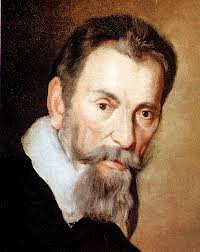 lessons from the maestro di capella of the Cremona Cathedral. He wrote his first motets and madrigals at the age of 15. Shortly after he moved to Mantua to serve at the court of Vincenzo Gonzaga. The duke was a major patron of arts, befriending the poet Torquato Tasso and employing the painter Peter Paul Rubens (two and a half centuries later Giuseppe Verdi would stage one of his most famous operas, Rigoletto, at the ducal palace). Monteverdi stayed in Mantua for more than 20 years; he married there and had children. His official position was that of the court conductor. In 1613 he moved to Venice to assume the same position in the basilica of San Marco, were Andrea and then Giovanni Gabrieli served as organists before him. In 1632 he became a priest. He lived in Venice for the rest of his life, and died there in 1643. He’s buried in the great basilica of dei Frari.
lessons from the maestro di capella of the Cremona Cathedral. He wrote his first motets and madrigals at the age of 15. Shortly after he moved to Mantua to serve at the court of Vincenzo Gonzaga. The duke was a major patron of arts, befriending the poet Torquato Tasso and employing the painter Peter Paul Rubens (two and a half centuries later Giuseppe Verdi would stage one of his most famous operas, Rigoletto, at the ducal palace). Monteverdi stayed in Mantua for more than 20 years; he married there and had children. His official position was that of the court conductor. In 1613 he moved to Venice to assume the same position in the basilica of San Marco, were Andrea and then Giovanni Gabrieli served as organists before him. In 1632 he became a priest. He lived in Venice for the rest of his life, and died there in 1643. He’s buried in the great basilica of dei Frari.
Monteverdi’s music spans two styles, that of the late Renaissance and the nascent Baroque. He wrote nine books of madrigals, church music and operas. You can listen to Parlo, miser'o taccio?, a madrigal from Book VII, here (Cettina Cadelo and Cristina Miatello, sopranos, Giovanni Faverio, bass) and to Dolcissimo uscignolo, from Book VIII, here (Anthony Rooley conducts his Consort of Musicke). Monteverdi’s truly revolutionary achievements were in opera. He wrote eighteen of them, but only L'Orfeo, which he wrote while in Mantua in 1607, Il ritorno d'Ulisse in patria(The Return of Ulysses to his Homeland), written in Venice around 1639, and L'incoronazione di Poppea (The Coronation of Poppaea), 1643, survive in complete form. L'incoronazione was revived at the end of the 20th century, and there are several recording of the opera. Here is the aria Disprezzata Regina from L'incoronazione. It’s sung by Frederica von Stade with Raymond Leppard conducting the Scottish Chamber Orchestra.
Maria Theresia von Paradis was born on May 15, 1759. She lost her sight at anearly age, but continued to study music (one of her teachers was Antonio Salieri) and became a concretizing pianist and singer. She also wrote several cantatas and some instrumental pieces. She’s famous for three things: for being treated by Franz Anton Mesmer, the inventor of mesmerism, with no lasting effects; for being a probable dedicatee of Mozart’s Piano Concerto no. 18; and for writing a beautiful piece called Sicilienne, even though these days many musicologists doubt the attribution. Here it is, played by Jacqueline du Pré, with Gerald Moore on the piano.Permalink
May 6, 2013. Brahms, Tchaikovsky – and Stamitz. Two great composers of the 19th century were born on May 7: Johannes Brahms in 1833, and Pyotr (or Peter Ilyich, as by some twist of linguistic fate he became known in the English-speaking world) Tchaikovsky seven years later. Last year to celebrate their birthdays we played their first piano concertos (Brahms wrote two, both great; Tchaikovsky – three, but only the first one remains popular, and for good reason). This time we’ll turn to their violin concertos. Brahms wrote his first and only violin concerto, Op. 77 in D Major, in 1878. It was dedicated to Joseph Joachim, Brahms’s friend and one of the most prominent violinists of the 19th century. Joachim premiered the concerto the same year in Leipzig, in a concert that also featured Beethoven’s violin concerto. Brahms himself conducted the Gewandhaus orchestra. Joachim composed the cadenza, which is the version we’ll hear, in the performance by the violinist Vadim Gluzman, with Saarbrücken Radio Symphony, Günther Herbig conducting.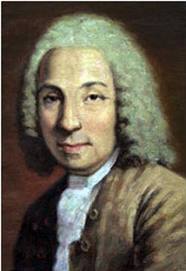
As it happens, Tchaikovsky also wrote his violin concerto, Op. 35, also in D Major ,and also in 1878. He was staying in Clarens, a small village not far from Montreux on Lake Geneva, recovering from his disastrous marriage to Antonina Milyukova. (Clarens had a number of connections with Russia: Stravinsky lived and wrote most of the Rite of Spring in Clarens in 1912, and later, in 1920, while there, wrote another ballet, Pulcinella. Vladimir Nabokov is buried in Clarens). Tchaikovsky dedicated his concerto to the famous violin teacher Leopold Auer, expecting him to play the premier. But Auer, who read the score presented by the composer, decided that he didn’t like the concerto and refused to perform it. Tchaikovsky was deeply hurt. The work was eventually premiered in Vienna by Adolph Brodsky, and Tchaikovsky changed the dedication to him. The concerto was rather poorly received; Eduard Hanslick, an influential critic and big supporter of Brahms, called it “pretentious.” Perceptions changed quickly, however, and since then Tchaikovsky’s concerto has become one of the most popular in the violin repertoire. We’ll hear it in the performance by Julia Fischer; Yakov Kreizberg conducts the Russian National Orchestra. Kreizberg, the brother of another famous conductor, Semyon Bychkov, died at the age of 51 in 2011, five years after this recording was made.
PermalinkCarl Stamitz is not as famous as either Brahms or Tchaikovsky, and deservedly so. Still, he wrote some very nice music, and probably more clarinet concertos than any other composer - eleven in all. Stamitz was born on May 8, 1745, in Mannheim. His father, Johann, a noted composer and violinist, was appointed to the court of the Elector several years earlier, and was Carl’s first music teacher. The Elector maintained an orchestra that was famous around Europe; Carl joined it at the age of 17. Among the court musicians there were a number of composers, who are now collectively known as Mannheim School. While not very famous nowadays, these composers, and Carl Stamitz among them, influenced both Franz Joseph Haydn and Mozart. In 1770 Carl left the orchestra and began a career of a traveling virtuoso: he played violin, viola, and viola d'amore (Carl eventually wrote several works for this instrument). He traveled all around Europe, playing concerts in Paris, London, Saint Petersburg, and many principalities of Germany. Eventually he moved to Jena, and died there, impoverished, in 1801. It’s said that in his last years his interests turned to alchemy. Stamitz’s Viola concerto was written in 1774. A lovely piece, it’s performed here by the German violist Tabea Zimmermann, with the European Union Chamber Orchestra, Dimitri Demetriades conducting.
April 29, 2013. Alessandro Scarlatti. These days Scarlatti-père is not as famous as his son Domenico, but in his day Alessandro was the foremost opera composer.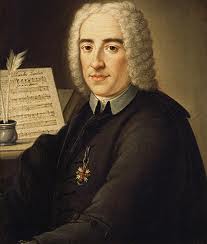 He was born in Palermo, the Kingdom of Sicily, on May 2, 1660. At the age of 12 he was sent to Rome. He wrote his first opera at the age of 19; Queen Christina of Sweden, who then lived in Rome, was impressed and offered her patronage. His work was noticed in Naples, at that time one of the greatest music centers of Europe, and in 1684 he became Maestro di Cappella to the viceroy of Naples. He stayed there till 1702 and wrote 40 operas. For a while he moved to Florence but then returned to Rome, where he was offered a position of Maestro di Cappella at the court of Cardinal Pietro Ottoboni (just some years earlier Arcangelo Corelli had the same patrons, Queen Christina and Cardinal Ottoboni). While in the employ of the Cardinal, he wrote several operas, including Il Mitridate Eupatore, which became very popular (here is the aria Cara tomba sung by the German coloratura soprano Simone Kermes). In 1706 Scarlatti was elected to the Accademia dell'Arcadia (as was Corelli). There he probably met the young Handel, who then lived in Rome and attended meetings of the Academy often. In 1709 Scarlatti moved back to Naples, where he continued to write at a furious pace: operas (he wrote a total 115 of them), masses and chamber cantatas. He retired from the viceroy’s court in 1723 and died two years later, on October 24, 1725.
He was born in Palermo, the Kingdom of Sicily, on May 2, 1660. At the age of 12 he was sent to Rome. He wrote his first opera at the age of 19; Queen Christina of Sweden, who then lived in Rome, was impressed and offered her patronage. His work was noticed in Naples, at that time one of the greatest music centers of Europe, and in 1684 he became Maestro di Cappella to the viceroy of Naples. He stayed there till 1702 and wrote 40 operas. For a while he moved to Florence but then returned to Rome, where he was offered a position of Maestro di Cappella at the court of Cardinal Pietro Ottoboni (just some years earlier Arcangelo Corelli had the same patrons, Queen Christina and Cardinal Ottoboni). While in the employ of the Cardinal, he wrote several operas, including Il Mitridate Eupatore, which became very popular (here is the aria Cara tomba sung by the German coloratura soprano Simone Kermes). In 1706 Scarlatti was elected to the Accademia dell'Arcadia (as was Corelli). There he probably met the young Handel, who then lived in Rome and attended meetings of the Academy often. In 1709 Scarlatti moved back to Naples, where he continued to write at a furious pace: operas (he wrote a total 115 of them), masses and chamber cantatas. He retired from the viceroy’s court in 1723 and died two years later, on October 24, 1725.
By the end of his life Scarlatti’s operas were eclipsed by Handel; not many of them are performed these days, although lately there has been somewhat of a revival. Still, not only did Scarlatti write some very lovely music, he was an innovator as well: for his operas he established a form of three-part overture, a forerunner of the classical symphony. You can listen to two arias from Scarlatti’s early operas. Beniamino Gigli, one of the greatest tenors of the 20th century, sings the aria "Già il sole dal Gange" from L'honestà negli amori (the opera was written in 1680). And here the technically perfect Cecilia Bartoli sings the aria O cessate di piagarmi from the opera Il Pompeo (1683).
Permalink